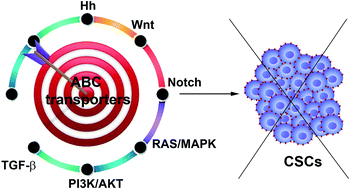Mutual regulation and targeting of multidrug resistance and cancer stem phenotype†
Abstract
Cancer-initiating cells referred to as cancer stem cells (CSCs) retain the essential property of self-renewal and protection. The protective mechanisms enable tumour regrowth even after the application of chemotherapy that was believed to be successful. Among the protective mechanisms of CSCs, the overexpression of ATP binding cassette (ABC) membrane transporters is highly important. ABC transporters involved in the development of cancer multidrug resistance (MDR) such as P-glycoprotein (P-gp) and breast cancer resistance protein (BCRP) are considered as particular features of CSCs. They provide a shield for CSCs and protect them from the adverse effects of chemotherapeutics. Hence, combating MDR would be one of the strategies for the elimination of CSCs. In order to investigate this phenomenon many model systems comprising MDR cancer cells have been established. Some of them were developed by a selection process through exposure to various anticancer drugs, others by transfection of genes for ABC transporters, while some were obtained by sorting the side population considered to possess stemness and resistant phenotypes. Herein we review the potential of cancer MDR models for studying CSCs because gaining a better insight into the mechanisms of CSC resistance to chemotherapy may lead to the discovery of new therapeutic targets and the development of better anticancer strategies.



 Please wait while we load your content...
Please wait while we load your content...